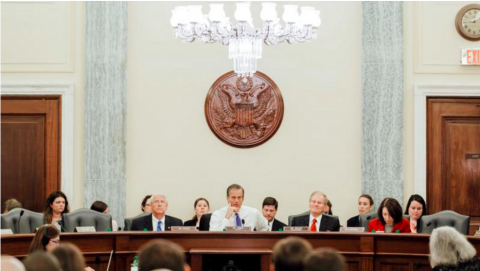The Senate's NASA Transition Authorization Act
Heather Bloemhard Vanderbilt University
 [Updated: 21 December 2016 to reflect the status of the bill at the end of the 114th Congress]
[Updated: 21 December 2016 to reflect the status of the bill at the end of the 114th Congress]
On 15 September 2016, the NASA Transition Authorization Act of 2016 (S. 3346) was introduced in the Senate by Senators Ted Cruz (R-TX), Bill Nelson (D-FL), Marco Rubio (R-FL), Gary Peters (D-MI), Roger Wicker (R-MS), and Tom Udall (D-NM). According to the Senate Committee on Commerce, Science, and Transportation press release, the legislation will provide "stability for NASA to sustain and build upon existing national space investments designed to advance space exploration and science with an overall authorization level of $19.508 billion for fiscal year (FY) 2017." Title I includes the authorization levels for NASA's directorates. See the table below where we compare these levels to recent appropriations levels; for more information on these appropriations levels, refer to previous posts about the Request, the Senate mark, and the House mark.
| Account | FY 2015 Enacted |
FY 2016 Estimate |
FY 2017 Request Total |
FY 2017 Senate Mark |
FY 2017 House Mark | Senate Authorizaton |
| NASA | $18,010 | $19,285 | $19,025 | $19,300 | $19,508 | $19,508 |
| Exploration | $3,543 | $4,016 | $3,337 | $4,330 | $4,183 | $4,532 |
| Space Operations | $4,625 | $5,025 | $5,076 | $4,951 | $4,890 | $4,951 |
| Science | $5,243 | $5,589 | $5,601 | $5,395 | $5,597 | $5,395 |
| Aeronautics | $642 | $633.8 | $790.4 | $601 | $712 | $601 |
| Space Technology | $600 | $686 | $827 | $687 | $739 | $686.5 |
| Education | $119 | $115 | $100 | $108 | $115 | $108 |
| Safety, Security, and Mission Services | $2,655 | $2,772 | $2,837 | $2,797 | $2,835 | $2,797 |
| Construction and Environmental Compliance | $446 | $415 | $420 | $400 | $398 | $400 |
| Inspector General | $37 | $37 | $38 | $38 | $38 | $38 |
Titles II, III, and IV focus primarily on human exploration of space:
- Title II discusses the need to sustain NASA's commitments in space and space exploration and reiterates NASA's long-term goal of a human presence beyond low-Earth orbit (LEO). In particular, NASA's balanced portfolio should include the continued development and operations of the space-launch system heavy-lift rocket (SLS), the Orion, commercial crew and cargo transportation, the James Webb Space Telescope (JWST), and the International Space Station (ISS).
- Title III discusses maximizing the utilization of ISS and LEO, including continuing the successful commercial transportation services that deliver cargo to ISS. The legislation also calls for regular reports to Congress that assess current LEO capabilities and challenges from the perspective of meeting the long-term goal of humans beyond LEO.
- Title IV delved into the topic of human exploration in deep space in greater detail. This includes enumerating goals and objectives for human space flight and exploration efforts and ensuring the health and safety of astronauts. The "Journey to Mars" is emphasized as a long-term goal of NASA. The legislation would authorize advancing space technology development in propulsion to shorten the trip to Mars to less than 60 days. Also included are a strategic framework and a critical decision plan for a Mars mission. The title expresses concern about the Asteroid Robotic Redirect Mission (ARM) as a step in the process of landing humans on Mars.
Title V focuses on advancing the space sciences; it states the importance of a balanced program and of following the guidance provided through the decadal surveys. Planetary science is discussed specifically as needing balance between small, medium, and large missions. The title instructs the Government Accountability Office (GAO) to continue to monitor the cost and schedule of JWST. The Wide-Field Infrared Survey Telescope (WFIRST) is included with the direction that progress should be made on the technologies and capabilities needed to complete WFIRST while maximizing the scientific productivity. The importance of the Mars 2020 rover is emphasized due to its impact on the long-term goal of landing humans on Mars. The title also indicates that a Europa mission that launches on the SLS should be supported.
Title VI discusses ways to maximize NASA's efficiency through information technology policies, cybersecurity policies, and collaboration among the mission directorates.
On 21 September 2016, the Senate Committee on Commerce, Science, and Transportation will consider this and five other pieces of legislation.
In September 2016, the Senate Commerce, Science, and Transportation Committee passed S. 3346, with 7 amendments, by voice vote. Three of the amendments include language about commercial space cooperation, and one adds a section about small balloon and satellite payload development. S. 3346 passed the full Senate by a legislative process called Unanimous Consent on 10 December 2016. It was sent to the House for consideration, but the House did not have time to take action on the bill before the end of the Congress.

